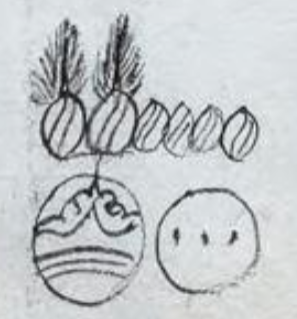peso (Osu30v)
This black-line drawing of the simplex glyph for a peso coin comes from the Codex Osuna, folio 30 verso (or Image 63). Although this glyph does not have a gloss confirming the name we are giving it, which is a loanword taken into Nahuatl from Spanish, the placement of the coin below some cacao beans and next to some tomines, helps assure the reading. This glyph for a peso has more decoration than the usual cross (+) found on other pesos. This one has three curving, horizontal lines in the lower half of the coin, and two nearly horizontal flourishes in the top half.
Stephanie Wood
The contextualizing image shows a notation for 804 cacao beans (400 + 400 + 4 = 804), counted by the Nahua number, the tzontli (400). Below the cacao beans are one peso and a sign for three tomines (three eighths of pesos). This was the apparent value in 1565 for that quantity of cacao beans, which were a pre-contact form of money and still in circulation well after colonization. In Tlaxcala in 1545, 200 cacao beans were said to be worth one eighth of a peso (see our Online Nahuatl Dictionary). Cacao was also the substance for making a hot chocolate beverage that the Nahua elite drank and for which the colonizers were acquiring a taste.
Stephanie Wood
1551–1565
Jeff Haskett-Wood
pesos, monedas, dinero, cacao, tzontles
peso, a coin worth eight reales, https://nahuatl.wired-humanities.org/content/peso cacahuatl, a cacao bean, https://nahuatl.wired-humanities.org/content/cacahuatl-0
el peso
Stephanie Wood
Library of Congress Online Catalog and the World Digital Library, Osuna Codex, or Painting of the Governor, Mayors, and Rulers of Mexico (Pintura del Gobernador, Alcaldes y Regidores de México), https://www.loc.gov/resource/gdcwdl.wdl_07324/. The original is located in the Biblioteca Nacional de España.
"The Library of Congress is unaware of any copyright or other restrictions in the World Digital Library Collection. Absent any such restrictions, these materials are free to use and reuse." But please cite the Biblioteca Nacional de España and this Visual Lexicon of Aztec Hieroglyphs if you use any of these images here or refer to the content on this page, providing the URL.




